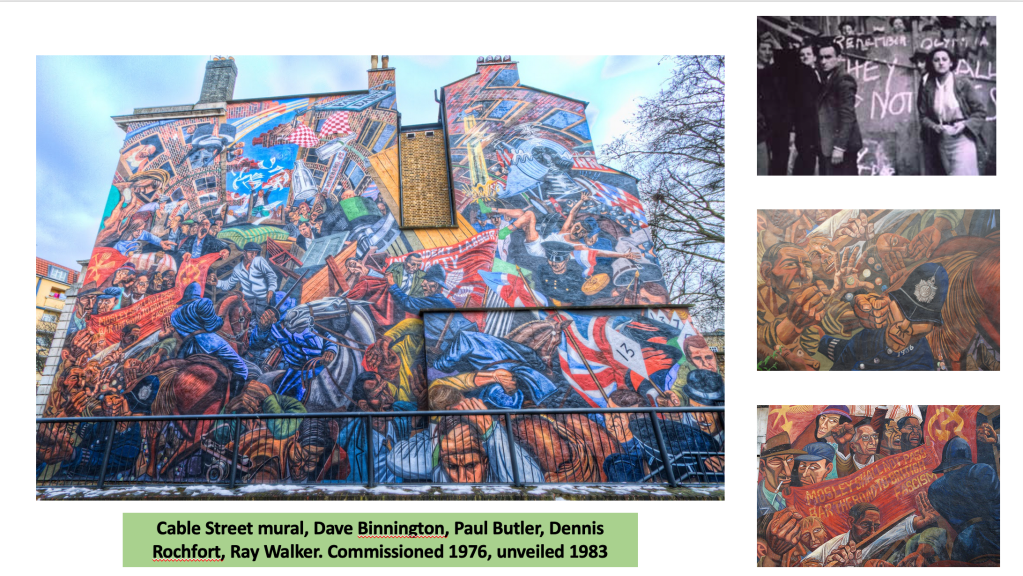Last night I was privileged to be part of a panel at the Tate Modern holding a discussion with each other and the audience on “What can murals do?”. Each panelist gave a 5 minute presentation. This was mine.
I’Il tell you what I don’t like. I don’t like statues. They literally place one person on a pedestal for achievements of the many. But I love murals as a beautiful expressive form to celebrate collective struggles. They use the everyday urban fabric to remind us: something momentous happened here. They summon us to action today.
Three examples are especially meaningful for me, but I hope they will resonate with you too, in these times. They are about courageous uprisings from below – the dignity of resistance against oppressors, persecutors, exploiters and fascists.
The first commemorates the iconic clash of fascism and anti-fascism on 4 October 1936, when thousands of uniformed, jackbooted fascists, inciting violence and hatred, sought to invade the streets where tens of thousands of working class Jews eked a living, They tried to win the local Irish Catholic community against the Jews. On the day the most bloody clashes were in Cable Street, where many Irish united with Jews to build barricades, to physically stop them. The fighting was with the police, ordered by the Home Secretary to facilitate the fascists free speech and movement.

The mural graces the side wall of St Georges Town Hall on Cable Street. It was commissioned In 1976 after a campaign by local writers, poets, artists who hatched their cultural creations in the basement of that building.
Every 5 years there is a memorial march. In 2016 I was convenor of Cable Street 80. We marched from Altab Ali park in Whitechapel – named for a young Bengali sweatshop worker murdered in a racist attack in 1978 – to a rally near the mural. The artwork is so dramatic, you can almost hear it. One commentator wrote: “Every space has action, perspective is a whirlpool.” For me It is a clarion call for resistance today.
Also in 1976, when work began in Cable Street, an industrial dispute broke out in a photo processing factory in Willesden, mostly staffed by poorly paid “citizens of Empire – South Asian migrant women plus Irish and Caribbean workers. When one worker was dismissed for allegedly working too slowly, some fellow workers immediately came out in solidarity. When a manager compared workers to “chattering monkeys”, Jayaben Desai replied ‘What you are running here is not a factory, it is a zoo. In a zoo, there are many types of animals. Some are monkeys that dance on your fingertips, others are lions who can bite your head off. We are the lions, Mr. Manager’. She led a walk out of 137 workers. An uprising.

Union groups across Britain came to the picket lines – the most remarkable, miners from Yorkshire’s white monocultural pit villages gave solidarity to Asian women migrant workers. Postal workers boycotted the company. Students came too. I nursed a large bump below my knee on the way back to Leeds Uni after a policemen kicked me. This fight for union recognition won great community support.
In difficult times, economically, the two year strike ultimately failed but inspired campaigns for change. It is celebrated in two murals unveiled in 2017 – one in a small backstreet opposite the factory site, now converted into flats. But on the main road, Dudden Hill Lane, is a stunning 28metre-long mural created in community workshops facilitated by artist Ann Ferrie. Participants included families of the strikers and schoolchildren. Archive photographs from the strike became stencils that were screenprinted, photographed, then digitally composited into artwork and printed on to boards. People of all artistic abilities saw their work in the final piece.

We travel eastwards for my third example in the heart of what was the Warsaw Ghetto from 1940-43. A mural on a school building by, Dariusz Paczkowski, depicts a defiant Marek Edelman, a daffodil in his fist, and a brick wall. Edelman, a Jewish marxist, and anti-nationalist, was Second in Command in the three-week uprising of a few hundred starved combatants with improvised weapons against the armed might of the Nazis. He wrote a searing memoir called The Ghetto Fights and always stressed it was a collective uprising whose participant had already survived two and a half years in the ghetto through a culture of mutual aid and countless quiet acts of daily resistance by so many.
I met him briefly in 1997. Last year I was in Warsaw for the 80th anniversary of the ghetto uprising. I took part in the alternative ceremony led by grassroots anti-racist and anti-fascists, in contrast to the militaristic official ceremony, brimming with Polish and Israeli flags.
Edelman died in 2009. He pioneered these alternative ceremonies, knowing that this history belonged neither to Polish nor Israeli nationalists. He said “we fought for dignity and freedom not for territory nor for a national identity.”
The words in Polish on this mural could not be more apt today. “Hatred is easy. Love requires effort and sacrifice.”
Excellent piece! As I’m sure you already know, there are several small murals scattered across the area that comprised the Łódź ghetto. One of them is of Marek Edelman, who I met in the late 1980s when I worked there.
Elsewhere in the city there are some other much bigger murals, one of Artur Rubenstein.
LikeLiked by 1 person
Thanks – yes, I visited Lodz briefly last April and met the director of the marek Edelman dialogue centre. I visited the mural of Edelman, and saw some other murals. I met Edelman briefly in 1997 in Warsaw at a conference on 100 years of the Bund.
LikeLike